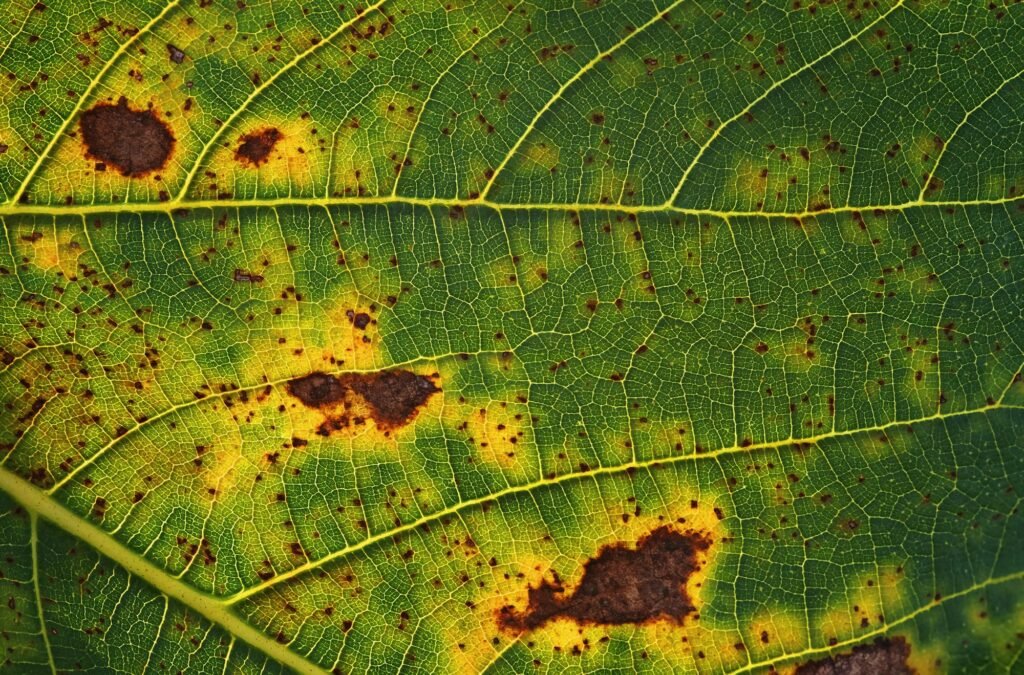Leaf spot disease is a common and widespread issue that affects a variety of plants, including trees, shrubs, and ornamental plants. As the name suggests, this disease is characterized by the appearance of spots on the leaves of infected plants. These spots can vary in color, size, and shape, and are usually caused by fungal or bacterial pathogens. Left untreated, leaf spot disease can weaken plants, reduce their aesthetic value, and even lead to severe health issues or death in extreme cases.
Identifying Leaf Spot Disease
Leaf spot disease manifests as small, discolored spots on the foliage of plants. These spots can be brown, black, yellow, or even reddish, depending on the specific type of pathogen involved. Over time, the spots may enlarge, merge, and cause significant leaf damage, leading to premature leaf drop. In severe cases, entire sections of a tree or plant can become defoliated, which weakens the plant and makes it more susceptible to other diseases and environmental stressors.
Common symptoms of leaf spot disease include:
- Discolored Spots: Small, round, or irregularly shaped spots that appear on the upper and lower leaf surfaces.
- Yellowing Leaves: As the disease progresses, leaves may turn yellow, a condition known as chlorosis.
- Premature Leaf Drop: Infected leaves may fall from the plant earlier than normal.
- Fungal Growth: In some cases, a powdery or velvety fungal growth may be visible on the surface of the spots.
Causes of Leaf Spot Disease
Leaf spot disease can be caused by various fungal and bacterial pathogens. The most common fungal culprits include species from the genera Cercospora, Phyllosticta, and Alternaria. Bacterial leaf spot diseases are often caused by pathogens like Xanthomonas or Pseudomonas.
These pathogens thrive in moist, warm conditions, which makes leaf spot disease particularly prevalent during the spring and summer months. Poor air circulation, overcrowded planting, and overwatering can create the perfect environment for these pathogens to flourish.
How Leaf Spot Disease Spreads
Leaf spot disease spreads through water, wind, and contaminated gardening tools or materials. Raindrops or overhead irrigation can splash spores from infected leaves onto healthy ones, promoting the spread of the disease. Additionally, wind can carry spores over short distances, affecting nearby plants. Handling infected plants or using tools that have not been properly sanitized can also transmit the disease.
Preventing and Managing Leaf Spot Disease
Prevention is key when it comes to managing leaf spot disease. Here are some practical steps to help protect your plants:
- Proper Plant Spacing: Ensure adequate spacing between plants to improve air circulation, which helps to keep the foliage dry and less hospitable to pathogens.
- Watering Techniques: Water plants at the base rather than overhead to minimize water splashing on the leaves. This helps reduce the chances of disease spread.
- Pruning and Maintenance: Regularly prune to remove infected leaves and branches. Dispose of these properly—preferably by bagging and discarding them in the trash rather than composting, as pathogens can survive in compost.
- Sanitize Tools: Always clean and disinfect gardening tools after use, especially when working with infected plants.
- Fungicide Application: In severe cases, applying a fungicide may be necessary. Always choose a fungicide that is labeled for the specific pathogen affecting your plants and follow the instructions carefully.
- Resistant Varieties: Consider planting disease-resistant varieties of trees and shrubs when possible. Many modern cultivars have been bred for improved resistance to common diseases, including leaf spot.
When to Call a Professional
While minor cases of leaf spot disease can often be managed with good gardening practices, severe infestations may require professional intervention. If you notice extensive leaf damage, widespread defoliation, or if the disease is recurring despite your best efforts, it’s time to call in the experts.
Certified arborists are equipped with the knowledge and tools to effectively diagnose and treat leaf spot disease and other tree health issues. If tree removal is ultimately necessary, Drury Tree Service has got you covered.
Conclusion
Leaf spot disease may be common, but it doesn’t have to be a death sentence for your plants. By understanding the symptoms, causes, and preventative measures, you can help keep your trees and shrubs in top shape. And when in doubt, don’t hesitate to reach out to a professional service like Drury Tree Service for expert advice and care. Protect your greenery from the unsightly and harmful effects of leaf spot disease, and enjoy a lush, vibrant landscape all season long.
For more information or to schedule a consultation, contact Drury Tree Service today. Let us help you keep your trees healthy, strong, and thriving!

